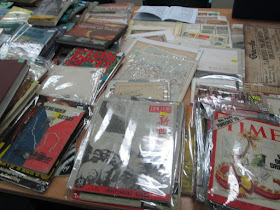By: Ambeth R. Ocampo
Philippine Daily Inquirer / August 16, 2019
 |
Prof. Ambeth Ocampo w/ Atty. Jorge Delos Santos,
founder of Bayanihan Collector Club |
The
Bayanihan Collectors Club brings accumulators of all
sorts to the Ortigas Library every quarter for an auction of anything
collectible: from
Spanish-Philippine gold coins to prewar Royal True Orange
bottles, from 1960s Pinoy porn, or “bomba” magazines to an autographed first
edition copy of “Noli me tangere.” You name it, chances are someone has it.
While I have no interest in the auction, I show up to scan
the bourse tables where collectors congregate to talk shop, swap or sell things
they don’t want anymore. Pickings are scarce these days since all important or
valuable artifacts now make their way to the high-end auction houses, yet one
never really knows what can result from patient digging through a pile of old
newspapers or photographs, using hunting skills honed from years of reading and
observation.
 |
| Old Philippine gramophone record by Maria Carpena |
In an
Ermita antique shop with a notoriously surly owner, I
came across small
phonograph records that played on what looked like nails at
78 revolutions per minute (rpm). Millennials who buy music online from Spotify
and iTunes will find old formats quaint: laser discs, compact discs, magnetic
tapes on large reels or the smaller cassette format; then there is vinyl for
“millenniors,” in large 33 rpm or smaller 45 rpm formats now making a comeback
with turntables. Some of the
78 rpm records I saw that day came in paper
sleeves with an image of the
Rizal Monument. That made me check each label, and
then cart away prewar recordings of Filipino performances of Western classical
music or the grandparents of OPM, or Original Pilipino Music. At P20 each, the
records were bait, trapping you into buying the “
grapopono.”
 |
| Julian Felipe's 1915 cedula (Picker Junk collection, http://pickerjunk.net) |
On another visit, I fished out of a pile of scrap paper, a
1914
cedula, or residence certificate issued to a 51-year-old “
Profesor de
Musica” from “XIII Martires, Cavite” named
Julian Felipe. The price was P50; I offered P10, we agreed on P35. Some people scolded me for
taking advantage of the seller by not informing him of its significance and
monetary value. Well, the seller won’t sell at a loss; at P35, he at least
broke even.
Experience is the euphemism we use for our mistakes, and all
collectors pay their dues, or “
matricula” when they buy a worthless
reproduction or an outright fake. Fortunately, my hits far outweigh my misses,
and one of my
recent jackpots was fishing out a
silver quill from an assortment
of scrap consigned to the melting pots of Meycauayan. Although black from
tarnish and neglect, I recognized the quill and its ribbon as a literary prize
awarded university students in 19th-century Manila. I have one allegedly
awarded Rizal in 1879 for his poem “
A la juventud Filipina.” But I withheld
this information from the seller, who fixed the price of the quill by its
weight and the spot price for silver that day—P700. When I cleaned the quill at
home, the text on the ribbon revealed that it was a prize for poetry awarded to
Emilio Jacinto y Dizon.
 |
| Filipiniana books for sale |
Last week, I discovered two
typewriter collectors who flew
under the radar until Tom Hanks admitted to a similar obsession, resulting in
increased prices and demand. I asked
Dennis Pinpin if he knew the stories that
came with each typewriter aside from its brand, model and year of production.
What was the provenance or sequence of ownership? Were any preowned by someone
famous? His collection is a book waiting to be written.
Could we tell from keyboards whether a typewriter was
sourced from abroad or locally? Typewriters of my youth had an “ñ” key, but
these were not Spanish keyboards that should also have “¿”; these were
specifically made for the Philippines, because they had the currency sign “P”.
George Dewey’s correspondence with Emilio Aguinaldo in 1898 was typed on
letterhead of the flagship Olympia, so when did Pinoys start using typewriters?
Did old Philippine keyboards come with the “g” or the tilde “˜” over the “g”,
which abounded in prewar Tagalog literature?
Every item can be
interrogated for a story, just as a group
of objects
reveals the personality of the person who pursued and gathered them.
Instead of adding to the millennial unboxing videos of smartphones and
sneakers, I will make millennior videos that will allow items in museums and
libraries to speak, to make connections with our past, provide relevance for
the present and hope for the uncertain future.
 |
| Items for auction |
 |
| Old Philippine magazines |
 |
| Philippine banknotes and cigar label |
 |
| Nintendo Game and Watch, Beer bottles and other memorabilia |
 |
| Maps, Spanish Philippine documents, and WWII currencies |
 |
| Prof Ambeth Ocampo with fellow collectors and friends |




















No comments:
Post a Comment